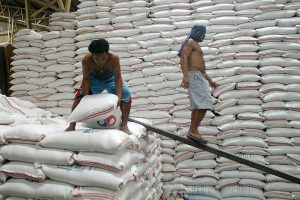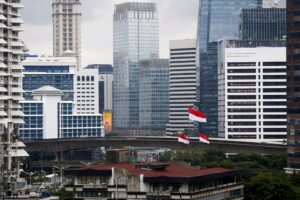Warnings from Washington

It must have been painful for the International Monetary Fund (IMF) to admit mea culpa for having failed to anticipate both the Asian Financial Crisis (AFC) of 1997-1998 which spilled over to East Asia, Latin America, and parts of Eastern Europe, and the Global Financial Crisis (GFC) of 2007-2009. If the 9-11 terrorist attacks demonstrated the failure of intelligence among the intelligence community, both crises unmasked the weaknesses of its fundamental role as a macroeconomic surveillance agency.
The lessons from both crises were dark and deep.
We realized that the most dynamic region of Asia then could be less resilient to cross-border capital flows. Corporate and bank borrowers funded their massive expansion through cheap dollar loans that turned from blessing to curse when capital suddenly stopped and reversed gear. Many borrowers lost money, forcing the governments of Indonesia, South Korea, and Thailand to avail of conditional loans from the Fund, something that ended up wrong. The literature was enriched with the lessons on the nature of the crises and the appropriate design of adjustment programs within the broad context of what came to be known as reforms in the international financial architecture. Crisis prevention, management, and resolution became prominent agenda items in local and global discussions.
For the Fund, based on the Fund staff article in Finance and Development in June 1998, the affected East Asian countries were the victims of their own success. They believed that foreign investors were led to underestimate their underlying economic vulnerabilities. Their banking systems were considered to have failed to keep pace with the demands for due diligence and prudent lending. Overheating pressures were not addressed quick enough. Most basic, the Fund also pointed to “lack of data and transparency” as well as “problems of governance and political uncertainties.” As late as a year after the Tom Yum crisis, the Fund maintained that “monetary policy must be firm enough to resist excessive currency depreciation.”
As Stijn Claessens observed in his article “Financial Cycles and Crises in Asia” in the ADB book Future of Regional Cooperation in Asia and the Pacific, published in November 2020, many economists and policy makers prior to the GFC conveniently ignored issues pertaining to financial cycles and macro-financial linkages. He quoted Stanley Fischer, then the Fund’s first deputy managing director, saying “I wasn’t used to thinking of the banking and financial sector as having such a critical role… floating exchange rates, tightening budgets, liberalizing markets and worrying about wages were all according to the book… Tesobonos were not,” in obvious reference to the Mexican Tequila crisis of 1994.
Despite the role of the financial sector in both the Tequila and Tom Yum crises, it looked like the Fund underestimated the severity of the weaknesses of the banks and other financial institutions and their interconnectedness in the major economies. New analytical tools had to be devised, including those for macro-financial risks and financial institutions which were systemically critical. The broader issue of financial stability that cut across economic sectors and involving various government regulators became a fixture in macroeconomic analysis and program design and monitoring.
By this time, the Fund has begun its difficult journey of reflecting on its time-honored, but not exactly time-tested, policy prescriptions. Conditionalities have been streamlined and appropriately modified to suit local conditions rather than the template prescribed in the staff brief. National authorities’ ownership of public policy has become increasingly important to ensure program success. Should conditions demand, some form of capital controls is no longer a cardinal sin. Regional self-help financial facilities have been encouraged on the basis of complementarity in mitigating financial crisis.
The two crises also birthed the Special Data Dissemination System, the Financial Sector Assessment Program, the Financial Stability Report, the various configurations of adjustment programs that exceed many times the member quotas. Policy integration is another. Jawaharlal Nehru’s famous quote is relevant here: “Crises and deadlocks when they occur have at least this advantage, that they force us to think.”
This year’s autumn meeting in Washington, DC therefore offers a new opportunity for the Fund to warn the world of the impending global crisis which arguably is now in progress. It was smart for the IMF Managing Director Kristalina Georgieva to have prepped up the central bank governors and finance ministers by her address before the students of Georgetown University the other Thursday, Oct. 6.
She was forthright in admitting that “our world economy is like a ship in choppy waters.” In the last three years, she observed that we all lived through shock, after shock, after shock. We all know the culprits and they are the pandemic, the Russian invasion of Ukraine, and climate disasters on all continents. There is a “fundamental shift in the global economy.” This is seen as we move from a world of relative predictability to one of greater fragility, uncertainty, and volatility.
The challenge to Georgieva is to prevent this situation from becoming a dangerous new normal.
Is there anything new to the Fund prescription? She called for stabilizing the global economy, revitalizing global cooperation, transforming economies, and building resilience against future shocks. Her mantra cannot be assailed, for it is to “act now and act together.” How to do it is the task of the on-going meetings of economic and financial leaders around the world in Washington, DC.
Her twin bases must have been drawn from the Fund’s official surveillance documents, namely, the World Economic Outlook (WEO) and the Financial Stability Report (FSR), both of which were issued one after the other only yesterday.
In her render, the global outlook is darkening with frustrated prospects of strong recovery this year and the next. Inflation became more persistent than transitory. As she flagged, “the risks of recession are rising.” Global output loss is estimated at $4 trillion, definitely not a small amount.
Stabilization to her means bringing down inflation, the cost of which could be enormous. There is a serious policy dilemma here which we pointed out in previous columns: not tightening enough could de-anchor and cement inflation which would require still higher rates, harming growth and jobs; but too much and too fast tightening could cause prolonged recession. Fiscal policy should be responsible. Joint efforts should also be undertaken to help the more affected emerging market and developing economies. Georgieva also called for transformational reforms like having fiscal space to support health, education, and stronger safety nets.
The Fund head’s warnings received evidentiary support from the presentation of the WEO and the FSR.
Briefly, the WEO theme, “Countering the Cost-of-Living Crisis,” could not have been more apt. The focus of WEO is the inflation scourge, described as higher than observed in several decades, leading to tight monetary policy that could harm economic growth if done too much and too fast. For WEO, the global economic future depends on the delicate balancing of monetary policy, what will come out of the Russia-Ukraine war, and further disruption in the global supply chain should the pandemic resurface with a vengeance.
With global growth expected to slow down from 6% in 2021 to 3.2% in 2022 and 2.7% in 2023, the Fund considered these prospects as the weakest since 2001 sans the GFC and the pandemic crisis. What is most disturbing is the Fund’s calculation that downside risks are dominant, particularly policy errors. For the benefit of central bankers, the Fund highlights the centrality of appropriate monetary policy: front-loaded and aggressive.
Inflation is indeed ubiquitous as global financial stability assessments now point to high inflation posing financial stability risks, together with spillovers from Russia and Ukraine as well as from the global energy markets. The FSR also observed that market liquidity has declined such that a sudden and disorderly financial tightening could conspire with pre-existing vulnerabilities to produce a fragile real sector.
In his blog today, Tobias Adrian, IMF Financial Counsellor, admitted that “financial conditions have tightened as central banks continue to hike interest rates. Amid the highly uncertain global environment, risks to financial stability have increased substantially.” What differentiates the two reports is the FSR’s focus on the elevated financial vulnerabilities facing governments with increasing debt levels, including nonbank financial institutions with bad balance sheets. Asset trading appears to have been affected by risk aversion resulting in higher borrowing costs for both sovereigns and corporates.
These latest warnings from Washington should inform incurably growth proponents who had in the past suggested to ignore inflation in favor of business activities, as if one could put a wedge between them. It would also be best to emphasize the role of communication in the successful conduct of monetary policy. There is clear and present danger to any forward guidance of solicitous clarity and anchoring on mainly present circumstances. Central bankers who speak too soon might have to pull back what was said off the cuff, but the harm could have been done.
Central bank credibility takes years to establish, but only a few months to lose.
(Next week: Implications on the Philippines)
Diwa C. Guinigundo is the former deputy governor for the Monetary and Economics Sector, the Bangko Sentral ng Pilipinas (BSP). He served the BSP for 41 years. In 2001-2003, he was alternate executive director at the International Monetary Fund in Washington, DC. He is the senior pastor of the Fullness of Christ International Ministries in Mandaluyong.




